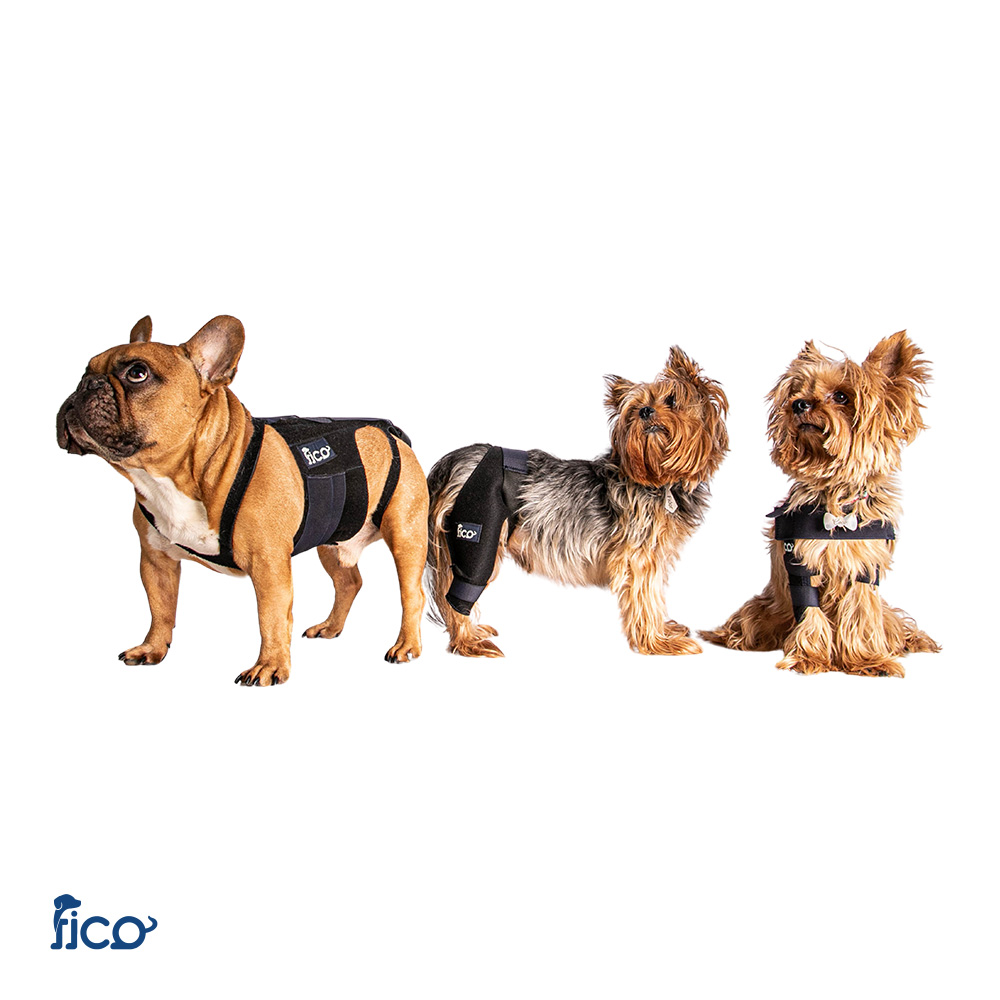What is IVDD in Dogs?
Intervertebral Disc Disease is a spinal condition in dogs that occurs when the cushioning discs between the vertebrae degenerate or rupture, leading to pain, nerve damage, and even paralysis. These discs act as shock absorbers for the spine, but with IVDD, they lose their flexibility and may herniate or bulge, pressing on the spinal cord. This compression can cause symptoms ranging from mild discomfort to severe mobility issues, depending on the severity of the condition.
IVDD is especially common in certain dog breeds due to genetic predisposition. According to the Pet MD, Breeds with long backs and short legs, such as Dachshunds, Corgis, Basset Hounds, and Shih Tzus, are particularly vulnerable. This is due to a condition called chondrodystrophy, which affects cartilage and leads to early disc degeneration. These breeds often experience IVDD at a younger age compared to others. Additionally, larger breeds like Labrador Retrievers and German Shepherds can develop IVDD due to age-related wear and tear on their spine. Since IVDD is a progressive disease, early detection and treatment, whether through medication, bracing, physical therapy, or surgery, are crucial for improving a dog’s quality of life and preventing severe complications like permanent paralysis.
Types of IVDD in Dogs
Intervertebral Disc Disease (IVDD) in dogs is classified into two main types: Hansen Type I and Hansen Type II.
Hansen Type I occurs when the disc’s outer layer suddenly ruptures, causing the inner material to press against the spinal cord. This type is often seen in young to middle-aged chondrodystrophic breeds, dogs with short legs and long backs. Symptoms appear suddenly and can range from mild pain to severe paralysis.
Hansen Type II, on the other hand, is a more gradual degeneration where the disc slowly bulges and compresses the spinal cord over time. This form is commonly found in larger breeds prone to IVDD, such as Labrador Retrievers, German Shepherds, and Doberman Pinschers. It typically affects older dogs and progresses slowly, often leading to chronic pain and mobility issues.
Both types of IVDD can severely impact a dog’s quality of life, but early diagnosis and treatment can improve outcomes. Since breeds prone to IVDD have a genetic predisposition, preventive measures like weight management, bracing and restricted jumping can help reduce the risk of spinal injuries.
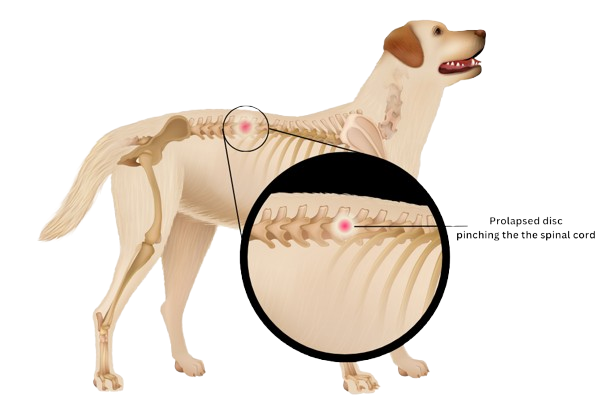
Causes and Risk Factors of IVDD in Dogs
Several factors contribute to IVDD’s development, including genetics, age, weight, and physical strain.Certain dog breeds are genetically prone to IVDD, particularly chondrodystrophic breeds, those with short legs and long backs. These breeds are at higher risk due to early disc degeneration. They often experience disc calcification, making them more susceptible to herniation.IVDD is more common in middle-aged to older dogs, typically between 3 to 7 years old. Excess weight puts extra pressure on the spine, increasing the likelihood of disc damage. A sedentary lifestyle or excessive jumping and running without proper conditioning also contribute to spinal stress, making dogs more vulnerable. Also, Sudden trauma, such as falling from a height or being hit, can trigger disc rupture. Repetitive high-impact activities, like constant jumping or intense agility training, can lead to gradual disc wear and tear. Dogs engaging in these activities without adequate muscle support have a higher risk of developing IVDD.
Symptoms and Diagnosis of IVDD
Intervertebral Disc Disease (IVDD) in dogs presents with a range of symptoms, from mild discomfort to complete paralysis. Early detection is crucial for effective treatment and preventing further spinal damage.
The first signs of IVDD often include back or neck pain, reluctance to move, and stiffness. Dogs may whimper, avoid jumping, or show difficulty standing up. As the condition progresses, weakness in the limbs, uncoordinated walking (ataxia), and dragging of the legs may occur. Severe cases can lead to total paralysis and loss of bladder or bowel control, requiring urgent medical intervention.
A veterinarian will assess the dog’s symptoms and perform a neurological exam to determine the affected spinal region. X-rays can help rule out fractures or tumors, but they don’t show soft tissues like intervertebral discs. Advanced imaging techniques such as MRI (Magnetic Resonance Imaging) and CT (Computed Tomography) scans provide a clearer picture of spinal cord compression and disc herniation. These tools help confirm IVDD, determine its severity, and guide treatment decisions, whether conservative management or surgery. Early diagnosis improves outcomes and helps prevent permanent damage.
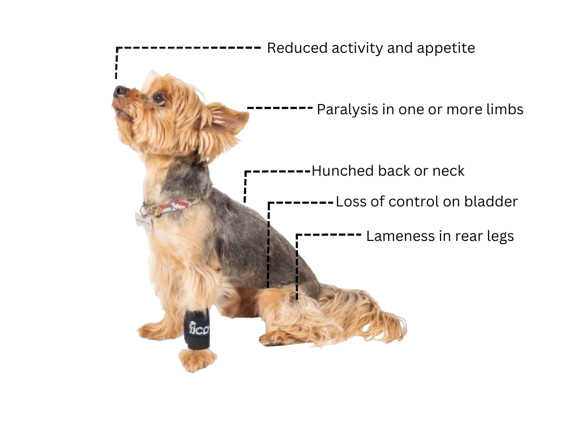
IVDD Treatment Options
Treatment for Intervertebral Disc Disease (IVDD) in dogs depends on the severity of the condition. In mild to moderate cases, a healthier lifestyle and/or bracing can help relieve symptoms and promote healing, while severe cases may require surgical intervention and extensive post-surgery care.
Conservative management is typically recommended for dogs with mild IVDD symptoms, such as pain or slight mobility issues. This approach includes strict crate rest for several weeks to prevent further spinal damage and allow the disc to heal. Veterinarians often prescribe anti-inflammatory medications, pain relievers, and muscle relaxants to manage discomfort and reduce swelling around the spinal cord. Physical therapy, including controlled exercises, Back braces, hydrotherapy, and laser therapy, can help improve mobility and prevent muscle atrophy. Some pet owners also explore acupuncture and chiropractic care as supportive treatments. Monitoring the dog’s activity levels and preventing excessive jumping or running is crucial for recovery.
At Fico, we’ve seen positive results in dogs with IVDD using our orthopedic back brace. Our brace provides targeted support, helping to stabilize the spine and reduce pain, especially for dogs with mild to moderate IVDD. The adjustable design allows for a customizable fit, offering comfort and flexibility while limiting strain on the affected area. Many pet owners have reported improvements in their dogs’ mobility and quality of life, with the brace helping to manage symptoms such as muscle spasms and discomfort. By supporting proper posture and reducing pressure on the spine, our back brace plays a crucial role in their recovery and well-being.
Surgery becomes necessary when a dog experiences severe or worsening symptoms, such as complete paralysis, loss of deep pain sensation, or unresponsiveness to conservative treatment. The procedure, typically a hemilaminectomy or ventral slot surgery, involves removing the herniated disc material to relieve pressure on the spinal cord. The success rate of IVDD surgery depends on the severity of spinal cord damage before the operation. Dogs that still have pain sensation in their limbs generally have a better prognosis than those who have lost all sensation. Post-surgical rehabilitation, including orthopaedic braces, physical therapy and controlled exercise, is essential for recovery and improving mobility.
For dogs that cannot undergo IVDD (Intervertebral Disc Disease) surgery, there are several treatment options available to manage their condition. Fico has worked with dogs suffering from advanced IVDD, and our hip brace has been a game-changer in helping them regain mobility. For dogs with paralyzed back legs, the brace provides essential support to the pelvic region, enabling pet owners to assist in their dog’s movement and help them walk again. The hip brace redistributes weight and reduces strain on the spine and hips, promoting better stability. Many pet owners have reported that the brace has allowed them to support their dog’s recovery by facilitating movement, ultimately improving their dog’s mobility and quality of life despite severe paralysis. Additionally, weight management and muscle strengthening exercises can help reduce strain on the spine. It’s essential to work closely with a veterinarian to determine the best treatment plan for each dog. Early intervention and proper treatment increase the chances of a successful recovery, whether through conservative management or surgery.
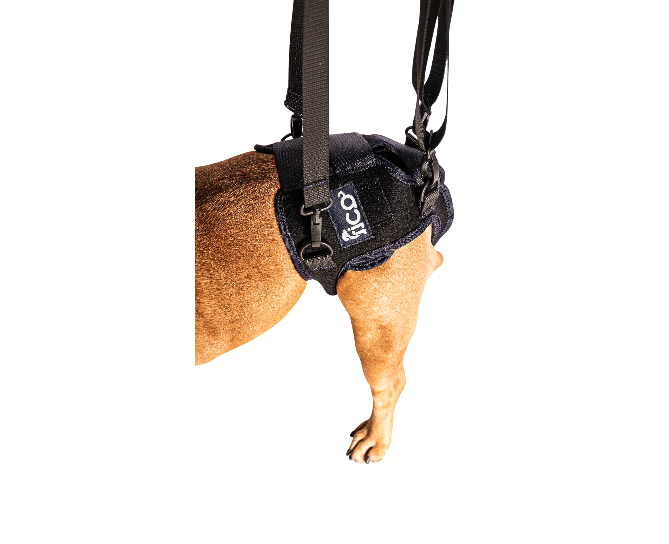
How to Prevent IVDD in Dogs
Preventing Intervertebral Disc Disease (IVDD) in dogs requires a proactive approach, focusing on weight management, exercise, and lifestyle adjustments to reduce strain on the spine. While genetics play a role, responsible care can significantly lower the risk of disc degeneration and injury.
Maintaining a healthy weight is crucial in preventing IVDD. Excess weight puts added pressure on the spine, increasing the likelihood of disc problems. Feeding a balanced diet with appropriate portion control helps prevent obesity. Regular, low-impact exercise strengthens muscles that support the spine. Activities like leash walks, swimming, and controlled play sessions promote fitness without excessive strain. High-impact exercises, such as jumping on and off furniture or running up and down stairs, should be minimized, especially in at-risk breeds like Dachshunds and Corgis.
Proper handling and lifestyle adjustments are also essential in reducing spinal stress. When lifting a dog, always support both the chest and hindquarters to avoid unnecessary pressure on the spine. Using ramps or stairs for access to furniture and vehicles can prevent repeated jumping. A well-padded, orthopedic brace provides spinal support and comfort, reducing stress on the back. Harnesses are preferred over collars to prevent neck strain, particularly in small breeds.
Regular vet check-ups can help identify early signs of IVDD and allow for preventive measures. Strengthening core muscles through controlled exercises, such as balance training or physical therapy, can further support spinal health. While IVDD cannot always be prevented, maintaining a healthy lifestyle and minimizing strain on the spine can reduce the risk and improve a dog’s overall well-being.
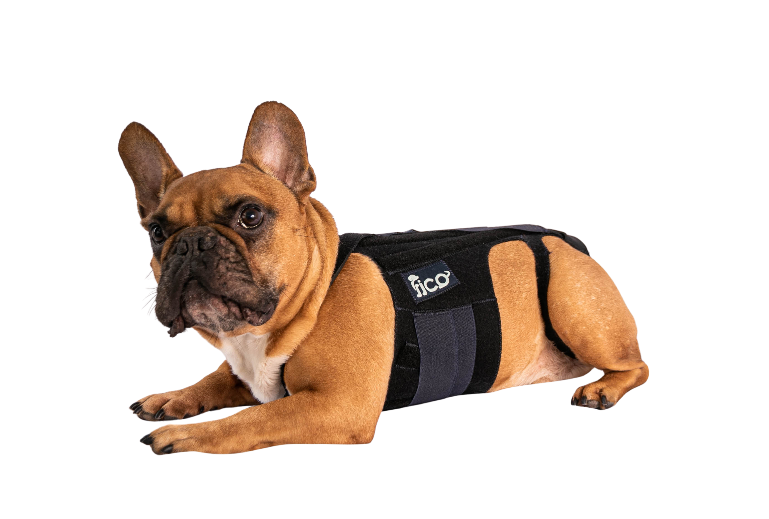
Genetic Testing & Breed-Specific Considerations
Certain dog breeds have a higher risk of developing Intervertebral Disc Disease (IVDD) due to their genetic makeup. Chondrodystrophic breeds, characterized by short legs and long backs, are particularly prone to this condition. Dachshunds have the highest risk, with studies showing that over 60% may develop IVDD in their lifetime. Other high-risk breeds include French Bulldogs, Corgis, Basset Hounds, Beagles, and Shih Tzus. These breeds often experience early disc degeneration, making them more susceptible to spinal issues.
Genetic testing plays a valuable role in IVDD prevention by identifying dogs that carry genes associated with early disc calcification. Some tests, such as those screening for the FGF4-retrogene, can help breeders make informed decisions to reduce the likelihood of passing on IVDD-prone traits. Responsible breeding programs aim to select dogs with lower genetic risk to improve overall breed health. While genetic testing does not eliminate IVDD risk entirely, it provides a useful tool in managing and reducing prevalence in affected breeds. Pet owners of at-risk dogs should be aware of IVDD symptoms and take preventive measures, including proper handling, weight management, and spinal support, to minimize the chances of disc-related issues.
IVDD is a serious condition, but with proper care, many dogs can live happy, healthy lives. Pet owners should stay proactive by managing their dog’s weight, providing spinal support, and recognizing early symptoms. Regular vet check-ups, safe exercise routines, and proper handling can help reduce the risk.
For added support, consider IVDD-friendly pet products like orthopedic beds, harnesses, and pet ramps to minimize spinal strain. Investing in your dog’s spinal health today can prevent serious issues in the future. Stay informed, take precautions, and give your furry friend the best chance at a pain-free life!
